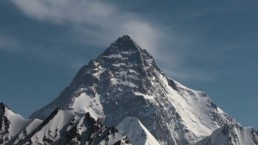‘The Summit’ Relives the Deadliest Day in Modern Mountain Climbing History
This is a custom heading element.
In cinema’s earliest beginnings, there stands the Lumiere Brothers’ historic film, The Arrival of a Train at La Ciotat (1895).
There is one main reason why this short film, less than a minute long and comprised of only one shot, is so important. For audiences who had never even seen “moving pictures” before, the sight of seeing a locomotive pull into a train station, towards the camera and incidentally, themselves, the feeling of realism scared audiences into believing the train was plowing straight towards them.
Boy, how those people would Gasp at watching a film whose camerawork transports them to the death-defying Summit of K2, the second-highest mountain on Earth.
A feature-length documentary, The Summit is a mixed collection of film devices, including interviews, real footage, and reenactment, that serve to tell the gripping, real-life account of the deadliest day in modern mountain climbing history.
The mountain is K2, located along the northwestern Himalayan mountain range and second-highest only to Mount Everest. Known as Savage Mountain, K2’s fatality rate claims one of every four climbers who attempt to summit (climb to the top), earning its reputation as the second most murderous mountain. And though its deadly power is known, it did not stop 22 climbers of several different international expeditions from attempting the climb on one fateful day in August 2008, leaving only 11 alive to tell the tale.
The threatening conditions, insurmountable odds, and dooming luck, all might beg to question why anyone would want to do this in the first place.
Directed by Nick Ryan, The Summit stands as his first major work as a feature-film director, a totally impressive feat for how much material is brought to the screen. The accomplishment of watching the camerawork, from helicopters above the mountain, on rigs and pulley systems to capture shots from stomach-churning angles, does as good a job to put the viewer right on the mountain save for being right there on the mountain. The impressive visuals alone are noteworthy, and add the right touch of tension while highlighting the power and beauty of the location.
As a narrative, the story shows, through real-life footage, the entire journey of the mountaineers. Focusing on a few veteran climbers, the first Irishmen to summit K2 Ger McDonnell, and a local sherpa to help others climb the mountain, Pemba Gyaljie Sherpa, the film tells all angles to attempt to discover what many are still unsure of; how exactly eleven veteran climbers were claimed by the mountain.
The takeaway is this: after seeing this film, you will feel immense respect for the all-powerful fate that nature has over man, and for the brave men and women whose thirst for adventure and exploration dare to defy it. The threatening conditions, insurmountable odds, and dooming luck, all might beg to question why anyone would want to do this in the first place. Though when you watch the scene of each mountain climber reaching the top of the mountain, taking pictures with their native country’s flag, hugging and kissing loved ones, and simply watching them look at the never-ending view around them, you can’t help but understand why the risk was worth it.
Ryan Rojas
Ryan is the editorial manager of Cinemacy, which he co-runs with his older sister, Morgan. Ryan is a member of the Hollywood Critics Association. Ryan's favorite films include 2001: A Space Odyssey, The Social Network, and The Master.


